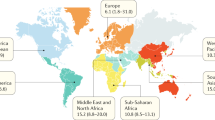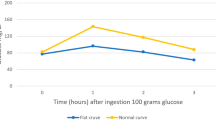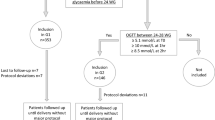Abstract
OBJECTIVE: To establish parameters associated with therapeutic success in gestational diabetics treated with glyburide.
STUDY DESIGN: A total of 69 gestational diabetics who failed dietary therapy were treated with glyburide. Inadequate glycemic control on maximum dose glyburide (10 mg b.i.d.) was considered treatment failure. The glyburide failure rate was calculated and factors that might predict success with glyburide were analyzed between the success and failure groups using χ2 or Student'st-tests.
RESULTS: The glyburide failure rate was 18.8%. Gestational age at glyburide initiation (p<0.01), pretreatment fasting blood sugars (p<0.001), and 1-hour postprandial values (p<0.001) were the only statistically significant factors between the two groups. Glyburide success was predicted if dietary failure occurred after 30 weeks, or fasting blood sugars were <110 mg/dl and 1-hour postprandials were <140 mg/dl (sensitivity 98%, specificity 65%).
CONCLUSION: Gestational diabetics who fail dietary therapy after 30 weeks gestation or have fasting blood sugars <110 mg/dl and 1-hour postprandials <140 mg/dl do well on glyburide therapy.
This is a preview of subscription content, access via your institution
Access options
Subscribe to this journal
Receive 12 print issues and online access
$259.00 per year
only $21.58 per issue
Buy this article
- Purchase on Springer Link
- Instant access to full article PDF
Prices may be subject to local taxes which are calculated during checkout
Similar content being viewed by others
References
Gestational Diabetes. ACOG practice bulletin no. 30. American College of Obstetricians and Gynecologists. Obstet Gynecol 2001;98:525–538.
Kemball ML, McIver C, Milner RD, Nourse CH, Schiff D, Tiernan JR . Neonatal hypoglycaemia in infants of diabetic mothers given sulphonylurea drugs in pregnancy. Arch Dis Child 1970;45:696–701.
Zucker P, Simon G . Prolonged symptomatic neonatal hypoglycemia associated with maternal chlorpropamide therapy. Pediatrics 1968;42:824–825.
Farquhar JW, Isles TE . Hypoglycemia in newborn infants of normal and diabetic mothers. S Afr Med J 1968;42:237–245.
Elliott BD, Langer O, Schenker S, Johnson RF . Insignificant transfer of glyburide occurs across the human placenta. Am J Obstet Gynecol 1991;165:807–812.
Elliott BD, Schenker S, Langer O, Johnson R, Prihoda T . Comparative placental transport of oral hypoglycemic agents in humans: a model of human placental drug transfer. Am J Obstet Gynecol 1994;171:653–660.
Langer O, Conway DL, Berkus MD, Xenakis EM, Gonzales O . A comparison of glyburide and insulin in women with gestational diabetes mellitus. New Engl J Med 2000;343:1134–1138.
Carpenter MW, Coustan DR . Criteria for screening test for gestational diabetes. Am J Obstet Gynecol 1982;144:768–773.
California Department of Health Services, Maternal and Child Health Branch. Sweet success: guidelines for care, 2001.
Author information
Authors and Affiliations
Rights and permissions
About this article
Cite this article
Chmait, R., Dinise, T. & Moore, T. Prospective Observational Study to Establish Predictors of Glyburide Success in Women with Gestational Diabetes Mellitus. J Perinatol 24, 617–622 (2004). https://doi.org/10.1038/sj.jp.7211147
Published:
Issue Date:
DOI: https://doi.org/10.1038/sj.jp.7211147
This article is cited by
-
Precision gestational diabetes treatment: a systematic review and meta-analyses
Communications Medicine (2023)
-
Can glyburide be advocated over subcutaneous insulin for perinatal outcomes of women with gestational diabetes? A systematic review and meta-analysis
Archives of Gynecology and Obstetrics (2020)
-
Pharmacological Management of Gestational Diabetes Mellitus
Drugs (2017)
-
Predicting failure of glyburide therapy in gestational diabetes
Journal of Perinatology (2016)
-
Pharmacological Management of Gestational Diabetes Mellitus
Current Diabetes Reports (2016)



